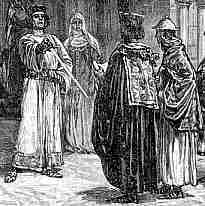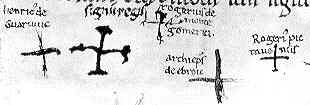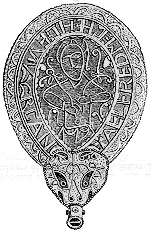 |
|
Law
and Administration |
 |
In
his wonderful book From Memory to Written Record M.T. Clanchy makes much of a tale, often illustrated in old school books,
concerning Earl Warenne and the commissioners of Edward I. The legend
goes that when asked by what warrant he held his lands, the Earl pulled
out a rusty sword, brandished it at the judges and claimed that the sword
used by his ancestor at the side of William the Conqueror was his charter.
Clanchy gives many reasons why this story could not be strictly true,
including that even in ye olde medieval days earls did not go about flourishing
naked blades at senior legal personnel representing the king. However,
he feels that the story has a sort of symbolic truth in that the 13th
century had been a crucial time of change in the methods of the law and
administration. |
|
A
traditional schoolbook representation of Earl Warenne and his sword. Note
that he is even pointing the blade at the commissioners. I think you could get hanged for that. |
|
|
Clanchy's
study limits itself to England in the period 1066 to 1307, but it illustrates
many generalities about the transition from a mode of conduct based around
witnessed oral testimony to one based on a proliferation of written words.
Despite the book's dense content, it is a great read. If you can find
one, have a go at it. |
|
Arguments
about literacy can sometimes become very entangled in definitions of what
literacy is, but it is important to try to see through the heavily constructed
concept of literacy and the literate mode of living with which we have
been indoctrinated since birth. Grab any oldfashioned history book and
find where lack of written record is equated with complete illiteracy,
ignorance, chaotic government, bad architecture, social inequity, long
hair and poor personal hygeine. |
|
King
Alfred the Great, from the late 9th century, has been presented to history
as a man who prized literacy and learning, who had great books translated
from Latin into Old
English. Some even say he did it himself, but the man at the top often
gets the credit for the efforts of his workers. The famed Alfred Jewel
is supposed to be a very posh bookmark, presented to some careless person
to encourage the valuation of the written word by association with high
class accessories. It has an inscription, itself a valuation of the word,
and we presume it was that Alfred who was mentioned in it. |
|
The Alfred Jewel |
| The
Alfred Jewel is a gold, enamel and rock crystal assemblage with a socket
at the end thought to have once held a long pointer. Like a number of
things found in muddy fields in days of yore, it now resides in the Ashmolean
Museum, Oxford. The inscription reads ÆLFRED MEC HEHT GEWYRCAN or
Alfred commanded me to be made. |
|
Alfred
did not, however, have a complex royal chancery
full of scribes organised into multiple secretariats. There are no archives
from his era, no books of laws, no records of the state of his treasury.
In fact, the number of legal or administrative documents dating from before
the Norman Conquest is extremely limited. |
|
Charters
or writs were produced
by Anglo-Saxon kings, so they knew about them and they used them. Of the
surviving 2000 or so, only a fraction exist as original authentic documents.
The rest survive as copies or later forgeries. It is impossible to answer
the question of how many have been lost to history, as in the absence
of an archiving system, lost is lost. |
|
|
A
segment from a charter of Coenuulf, King of Mercia, of 812. |
|
What
is known is that it was long after the Norman Conquest before legal and
administrative affairs were conducted in a truly literate mode. The charter
or writ was really a ceremonial object which served to symbolise a transaction
carried out in oral mode. This does not mean that people were necessarily
completely illiterate. It means that literacy was not conceptualised as
part of this aspect of living, which had a long oral tradition. |
|
Some
early charters were not dated. None were signed. They comprised a form
of public statement which was authenticated by the names of the witnesses
present. These witnesses did not sign either. Their names were entered
on the document by the scribe,
in pre-Conquest and early post-Conquest documents beside a sign of the
cross. This symbolised the solemnity of the witnessing process whereby
the witnesses swore an oath before Christ as to the truth of what they
were witnessing. Later authentication of the transaction required, not
the document itself, but the oral testimony of the witnesses. It was essentially
an oral process, the piece of parchment
not being a legal document in the modern sense of requiring all legalistic
conditions to be entered in writing, but rather being a symbolic object
whose existence testified that a legal transaction had been carried out. |
 |
Crosses
of the king (second left) and some of the witnesses to a late 11th century
charter in Eton College Library. |
|
This
is how the story of Earl Warenne's sword has an aspect of authenticity,
even if it is not exactly true. A sword, a knife or another object could
serve as the token of faith in an oral transaction as well as a piece
of parchment scribbled on by a scribe. In the period of transition, there
are written records which refer to the process of oral testimony. |
|
|
|
A
grant by knife  |
| In
the days before the existence of a royal chancery, when the scribe was a
learned monk, the piece of parchment may well have assumed a value related
to an esteem for written works as objects of worth rather than to the content
of the words. A similar psychology may apply to the practice of recording
legal transactions in a blank leaf of a gospel
book, the Biblical
reference underlying the solemnity of a transaction under oath and the book
itself serving as a ceremonial object of value. |
|
continued  |
 The
Concept of Literacy The
Concept of Literacy |
|
 |
 |
 |
 |
 |



